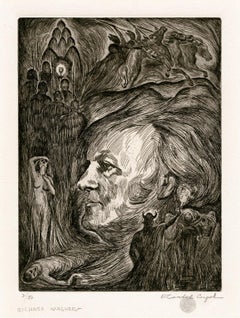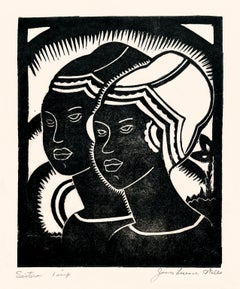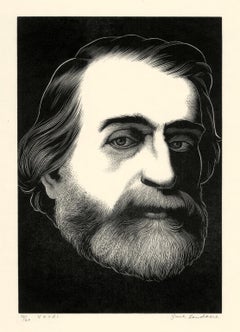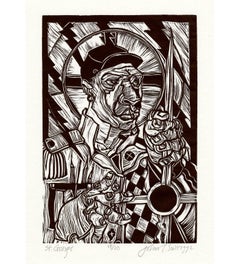Want more images or videos?
Request additional images or videos from the seller
1 of 3
Emil Singer'Beethoven' - c 1920 etching portraitc. 1920
c. 1920
Price:$475
$550List Price
About the Item
About the Seller
5.0
Recognized Seller
These prestigious sellers are industry leaders and represent the highest echelon for item quality and design.
Platinum Seller
Premium sellers with a 4.7+ rating and 24-hour response times
Established in 1995
1stDibs seller since 2016
318 sales on 1stDibs
Typical response time: 1 hour
Associations
International Fine Print Dealers Association
Authenticity Guarantee
In the unlikely event there’s an issue with an item’s authenticity, contact us within 1 year for a full refund. DetailsMoney-Back Guarantee
If your item is not as described, is damaged in transit, or does not arrive, contact us within 7 days for a full refund. Details24-Hour Cancellation
You have a 24-hour grace period in which to reconsider your purchase, with no questions asked.Vetted Professional Sellers
Our world-class sellers must adhere to strict standards for service and quality, maintaining the integrity of our listings.Price-Match Guarantee
If you find that a seller listed the same item for a lower price elsewhere, we’ll match it.Trusted Global Delivery
Our best-in-class carrier network provides specialized shipping options worldwide, including custom delivery.You May Also Like
Self Portrait by Jim Dine (plate seven from Self Portraits portfolio 1971)
By Jim Dine
Located in New York, NY
Jim Dine, Self Portrait 1971
drypoint on Hodgkinson Hand Made Tone-Weave paper
Paper 18 x 14 in. / 46 x 36 cm
Plate 8 x 6 in. / 20 x 15 cm
plate seven from Self Portraits (1971) port...
Category
1970s Realist Portrait Prints
Materials
Etching, Drypoint
$1,500
H 20.5 in W 15.5 in
Untitled (Portrait)
By William H. Bailey
Located in Fairlawn, OH
Untitled (Portrait)
Drypoint printed in blue-black graphite mixed with silver, 1974
Signed and dated lower ight (see photo)
From: Series entitled Six Drypoints
Edition: 23 (4/23)
Numbered lower left (see photo)
Print Shop: Crown Point Press
Printer: Jeannie Fine
Publisher: Parasol Press, New York
Note: A portfolio is in the collection of the National Gallery, Australia, Fine Arts Museums of San Francisco- de Young/Legion of Honor, Davis Museum at Wellesley College and the Yale University Art Gallery.
Condition: Excellent
Image/Plate size: 6 3/8 x 5 3/8 inches
Sheet size: 24 x 20 inches
From a portfolio of six drypoints, printed with unqiue combination of blue-black graphite shavings combined with silver to create the appearence of an original drawing. I know of no other artist to use a similar printing technique.
William Bailey studied art at the University of Kansas, Yale University and Yale School of Art where he studied with Josef Albers receiving his MFA in 1957.
Mr. Bailey’s first exhibition in New York was at Robert Schoelkopf Gallery in 1968, where he showed regularly until its closing in 1990. During the 90’s he exhibited at the Andre Emmerich Gallery and on its closing, exhibited at the Robert Miller Gallery. In 2004 Bailey moved to the Betty Cuningham Gallery where his most recent exhibition was held from April 30 - June 11, 2016.
Mr. Bailey’s work has been exhibited extensively in both America and Europe. He is represented in the collections of The Whitney Museum of American Art, The Museum of Modern Art, the Pennsylvania Academy of Fine Arts, and the Hirschhorn Museum and Sculpture Garden, among others. He was awarded a Guggenheim Fellowship in painting in 1965. Mr. Bailey was elected to The National Academy of Design in 1983 and to The American Academy of Arts and Letters in 1986.
Mr. Bailey taught at The Yale School of Art from 1958 to 1962 and from 1969 to 1995. He has also taught at The Cooper Union, University of Pennsylvania and Indiana University. He maintains studios in New Haven and in Umbertide, Italy.
Courtesy Betty Cunningham Gallery
Tribute to William Bailey
THE NEW YORK TIMES
William Bailey, whose pristine, idealized still lifes and female nudes made him one of the leading figures in the return of figurative art in the 1980s, died on April 13 at his home in Branford, Conn. He was 89.
His death was confirmed by his daughter, Alix Bailey.
Beyond his painting, Mr. Bailey influenced generations of students in his many years as a teacher at the Yale School of Art.
In some of his best-known work, Mr. Bailey arranged simple objects — the eggs, bowls, bottles and vases that he once called “my repertory company” — along a severe horizontal shelf, or on a plain table, swathing them in a breathless, deceptively serene atmosphere heavy with mystery.
William Bailey, Modernist Figurative Painter, Dies at 89
He swathed his nudes and still lifes of eggs, vases, bottles and bowls in a breathless, deceptively serene atmosphere heavy with mystery.
The painter William Bailey in 2009. He was never given a career survey in a major museum, but his influence, particulary on students at Yale, was deep.
Ford Bailey
By William Grimes for the New York Times
April 18, 2020
William Bailey, whose pristine, idealized still lifes and female nudes made him one of the leading figures in the return of figurative art in the 1980s, died on April 13 at his home in Branford, Conn. He was 89.
His death was confirmed by his daughter, Alix Bailey.
Beyond his painting, Mr. Bailey influenced generations of students in his many years as a teacher at the Yale School of Art.
In some of his best-known work, Mr. Bailey arranged simple objects — the eggs, bowls, bottles and vases that he once called “my repertory company” — along a severe horizontal shelf, or on a plain table, swathing them in a breathless, deceptively serene atmosphere heavy with mystery.
His muted ochres, grays and powdery blues conjured up a still, timeless world inhabited by Platonic forms, recognizable but uncanny, in part because he painted from imagination rather than life.
“They are at once vividly real and objects in dream, and it is the poetry of this double life that elevates all this humble crockery to the realm of pictorial romance,” Hilton Kramer wrote in The New York Times in 1979.
Mr. Bailey’s female figures, some clothed in a simple shift or robe and others partly or entirely nude, are disconcertingly impassive, implacable and unreadable, fleshly presences breathing an otherworldly air.
The critic Mark Stevens, writing in Newsweek in 1982, credited Mr. Bailey with helping to “restore representational art to a position of consequence in modern painting.”
But his version of representation was entirely idiosyncratic, seemingly traditional but in fact “a modernism so contrarian,” the artist Alexi Worth wrote in a catalog essay for the
William Harrison Bailey...
Category
1970s Realist Portrait Prints
Materials
Drypoint
Similitudes
By Jean-Louis Forain
Located in New York, NY
Jean- Louis Forain (1852-1931), Similitudes, etching and drypoint, not signed [signed in the plate upper right], 1880, from the total edition of 545, on wove paper, in generally good...
Category
1880s Realist Portrait Prints
Materials
Drypoint
Mary Cassatt "By the Pond"
By Mary Cassatt
Located in Los Angeles, CA
Mary Cassatt 1844 - 1926
"By the Pond" (Breeskin 161; Matthews & Shapiro 21)
Drypoint and aquatint printed in colors, circa 1896, on laid paper, framed
Fourth state of four.
Plate:...
Category
1890s Portrait Prints
Materials
Drypoint, Aquatint
Semen: large scale expressionist nude male figure portrait, floating in pink
By Francesco Clemente
Located in New York, NY
This large scale, ethereal portrait depicts a tranquil male nude figure floating in pink and blue. Based on a tempera painting, an expressionist, emotive piece to bring dramatic impa...
Category
1980s Contemporary Nude Prints
Materials
Drypoint, Etching, Aquatint
J. Becquet, Sculptor
By James Abbott McNeill Whistler
Located in Fairlawn, OH
J. Becquet, Sculptor
Etching & drypoint, 1859
Unsigned as issued
From: The Thames Set
Printed on this Japanese tissue
Rich impression
Condition: Excellent
Plate/Image size: 9 7/8 x 7...
Category
19th Century Impressionist Portrait Prints
Materials
Drypoint, Etching
Chinois inventa, dit-on, la poudre a canon, nous en fit don
By Georges Rouault
Located in Fairlawn, OH
Chinois inventa, dit-on, la poudre a canon, nous en fit don
(The Chinese invented gunpowder, they say, and made is a gift of it)
Aquatint, roulette, drypoint, acid bite, and scorper...
Category
1920s French School Portrait Prints
Materials
Drypoint, Aquatint
$1,750
H 25.5 in W 19.75 in
Salvador Dali - La Fontaine Portrait - Handsigned Engraving
By Salvador Dalí
Located in Collonge Bellerive, Geneve, CH
Salvador Dali - La Fontaine Portrait - Handsigned Engraving
1974
Hand signed by Dali
Edition: /250
The dimensions of the image are 22.8 x 15.7 inches on 31 x 23.2 inch paper
Referenc...
Category
1970s Surrealist Figurative Prints
Materials
Drypoint, Aquatint
$2,985
H 29.93 in W 22.84 in D 0.04 in
Feuille d'etudes Techniques: Neuf Tetes
By Pablo Picasso
Located in New York, NY
Etching and drypoint on laid paper, 1934. With Picasso's ink stamped signature lower right, and numbered 29/50 in pencil lower left.
Image 12.25 x 8.75 inches, full sheet 19.5 x 13...
Category
1930s Modern Portrait Prints
Materials
Etching, Drypoint
Autoportrait a la Pipe
By André Derain
Located in New York, NY
Etching and drypoint on cream laid paper.
Catalogue raisonne reference: Adhemar 44.
Category
1910s Fauvist Portrait Prints
Materials
Drypoint, Etching
More From This Seller
View All'Richard Wagner' — 1920s Portrait of the Composer
Located in Myrtle Beach, SC
Francis Coradal-Cugat, 'Richard Wagner', etching, c. 1928. Signed, titled, and numbered ‘2/50’ in pencil with the artist’s inked fingerprint beneath his signature. A fine, richly ink...
Category
1920s Romantic Portrait Prints
Materials
Etching
'Sisters' — Renowned Black American, Harlem Renaissance Artist
Located in Myrtle Beach, SC
James Lesesne Wells, 'Sisters', linocut, edition not stated but small, 1928. Signed, titled, and annotated 'imp' in pencil. A fine impression on off-white wove Japan paper, with wide margins (1 7/8 to 3 3/4 inches), in excellent condition. Printed by the artist. Very scarce. Matted to museum standards, unframed.
Image size 8 3/16 x 6 3/4 inches (208 x 171 mm); sheet size 13 1/2 x 10 3/4 inches (343 x 273 mm).
Exhibition and Literature: 'Narratives of African American Art and Identity: The David C. Driskell Collection,' The Art Gallery at the University of Maryland, extensive touring exhibition, 1998-2000.
Collections: Pennsylvania Academy of the Fine Arts, Smithsonian Institution (Anacostia Community Museum).
ABOUT THE ARTIST
“Wells is more than an artist with a deep concern for his fellow man. He carries many of his themes a step further into an apocalyptic world, a world of revelation and shifting lights. … He works on large blocks in a bold free style. … His work has a vigor, therefore, that is not often used in the medium today.”
—Jacob Kainen (painter, critic, and collector) from Richard J. Powell’s 1986 essay Phoenix Ascending: The Art of James Lesesne Wells.
James Lesesne Wells was an American painter, printmaker, educator, and pioneering figure of the Harlem Renaissance, whose work established a vital connection between African heritage, modernist form, and African American cultural identity. Known for his innovative use of linoleum and woodblock printing, Wells played a key role in shaping 20th-century African American art and inspired countless students throughout his lengthy career as a teacher at Howard University.
Born in Atlanta, Georgia, Wells' early exposure to the arts came through church and community, where African American cultural traditions were central. He pursued formal artistic training at Lincoln University in Pennsylvania (earning a B.A. in 1924), followed by studies at the Pennsylvania Academy of the Fine Arts and the Barnes Foundation, where he encountered European modernists as well as traditional African sculpture, which profoundly influenced his style.
Wells moved to New York in the late 1920s, swiftly immersing himself in the lively artistic and intellectual scene of Harlem. There, he became associated with artists, writers, and thinkers of the Harlem Renaissance, contributing to the growth of Black cultural identity. Considered a mentor to many famed artists of the Harlem Renaissance, Wells served as director of a summer art workshop in Harlem where his assistants included Charles Alston, Jacob Lawrence, and Palmer Hayden...
Category
1920s American Modern Figurative Prints
Materials
Linocut
'Verdi' — American Modernism - Italian Opera Composer
By Paul Landacre
Located in Myrtle Beach, SC
Paul Landacre, 'Verdi', wood engraving, 1936, edition 60, (only 14 printed), Wien 188. Signed, titled, and numbered '10/60' in pencil. A fine impression, on cream, laid Japan paper, ...
Category
1930s American Modern Portrait Prints
Materials
Woodcut
St. George — African American artist
By John Tarrell Scott
Located in Myrtle Beach, SC
John Tarrell Scott, 'St. George', woodcut, edition 20, 1992. Signed, dated, titled, and numbered '18/20' in pencil. A fine, black impression, on off-white, laid Japan paper, with ful...
Category
1990s Contemporary Portrait Prints
Materials
Woodcut
'Riders at Sundown' — Mid-Century Southwest Regionalism
By Gene Kloss
Located in Myrtle Beach, SC
'Riders at Sundown', aquatint and drypoint, edition 75, 1953, Kloss 451. Signed, titled, and annotated 'Artist's Proof' in pencil. A superb, richly-inked, atmospheric impression, in ...
Category
1950s American Modern Landscape Prints
Materials
Drypoint, Aquatint
'Noonday Shadows' — Mid-Century Southwest Regionalism
By Gene Kloss
Located in Myrtle Beach, SC
'Noonday Shadows', etching and drypoint, edition 75, 1941, Kloss 376. Signed, and titled in pencil. A superb, richly inked impression, in warm black ink, on buff wove paper, in excel...
Category
1950s American Modern Landscape Prints
Materials
Drypoint, Etching



